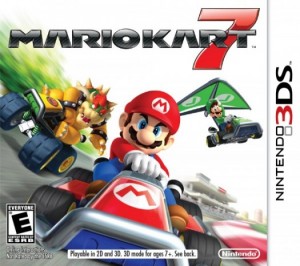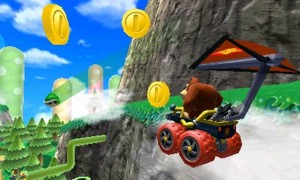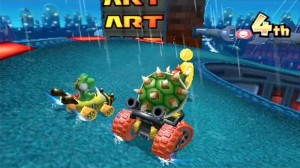Mario Kart needs to change.
Mario Kart 7, more than ever, is an example of a solid foundation that has been bogged down over the years by a lack of innovation and refusal from Nintendo to let a franchise grow with its original audience. Also, the blue shell breaks the game.
While the Super Mario and Zelda series’ are making changes – albeit minor – to their long-standing formulas, the changes are largely positive and the games are still able to hold their place among the top tier titles of this generation. With Mario Kart 7 however, the Mario Kart formula has proved itself embarrassingly behind the times by limiting its few innovations and allowing an easily fixable mechanic ruin the game.
There are positive elements about the game when not considered as part of the whole. The graphics are some of the best on the system, and the 3D effect is even more smoothly integrated than it is with Super Mario 3D Land. Of course, the 3D does not add anything to the gameplay like it does with 3D Land. Also, Super Mario 3D Land is a good game.
Another positive addition when considered in isolation is the return of speed boosting coins from the Super Nintendo and Game Boy Advance titles. In contrast to the short boosts of speed that the mushroom item or speed panels provide, these coins can be collected to a maximum of ten to give an overall boost to a kart’s top speed. It is an excellent mechanic in theory, as coins are often placed off the optimal path so the player must choose whether it is worth it to sacrifice an early lead for a more long-lasting benefit.
Before this facade of a game worth playing is broken down, there are a few more illusions of positivity to add. Mario Kart 7 boasts some excellent track design. Shortcuts are many and are often refreshingly skill-based. If a player does not tackle a shortcut in precisely the right way, the path will often slow his progress more than if he had opted to not attempt the alternate path.
In addition, a handful of tracks drop the three-lap formula and instead opt for a much longer non-looped track divided into three sections. The change makes for some appreciated variety and requires players to become truly familiar with the layout to take full advantage of the design. The only downside to this new take is that there are so few instances. There are also sixteen classic tracks, so surely it would not have been too big of a risk to design all the new tracks in this manner.
Finally, Mario Kart 7 continues Mario Kart DS‘ trend of harboring one of the only competent online Nintendo games. The online functionality is quick, intuitive, and reads the player’s overarching 3DS friend list, eliminating the need for those annoying separate friend codes. However, there is no option to turn off items in general online play and that is where the very fabric of Mario Kart 7 begins to unravel.
Because unfortunately, items are not always on just in online play, but in the single-player Grand Prix challenges as well. These two modes are the meat of the franchise and the return of the heat-seeking blue shell and – to a lesser extent – the lightning bolt break the experience. The blue shell is not merely an annoying presence that must be ignored. It literally renders the rest of the game irrelevant. Mario Kart 7 might as well be a dice-rolling simulator. It would serve a very similar function.
It is possible for a player to be in first place with ten coins in hand when, in the middle of a jump, a lightning bolt shoots him out of the air scattering a portion of his coins and all his items. Then when he lands (losing more coins for falling off-course), it is possible that he will get hit again by a blue shell that was tracking him. This causes him to lose the remainder of his hard-earned coins while watching his position fall to near-last through absolutely zero fault of his own.
That scenario is not only possible, but frighteningly common. In fact, the lightning bolt/blue shell combination happened to this reviewer on frequent occasion while playing. It is a mechanic that rewards bad play and punishes good play. That mechanic has no place in a game. Especially when these items are impossible to avoid or defend against. Even the far-fetched strategy of intentionally starting poorly to hope for an invincibility star item for later use is rendered void by the item-removing lightning bolt.
All this is made more frustrating when it is considered that the 150cc Mode would be a legitimate challenge without the presence of items. It is made more frustrating knowing that the online multiplayer could have been a legitimately competitive experience.
Mario Kart 7 has tight controls, clever track design, and tough-as-nails AI at the hardest setting. When a player loses in a very rare legitimate race, it is encouragement to brush up on his skill. He can review his play and find ways to improve in the future. However, when he loses far more often by literally no fault of his own, he feels deservedly shafted. The point of the game becomes futile as skill ceases to be a factor.
The incredibly easy remedy of an item switch option is, sadly, nowhere to be found in the single-player and online modes. If the Super Smash Bros series did not have an item switch option, there is no way that so many people would still hold fevered tournaments of its various games to this day.
Mario Kart 7 is a game that has great elements that are made entirely irrelevant on account of blind, stubborn, and easily amendable design choices. Mario Kart 7 is a frustrating experience. Any gamer who would like his skill to impact his results should pass on this title without a second thought.
Full disclosure: the author was provided with a free copy of the game for review purposes.


